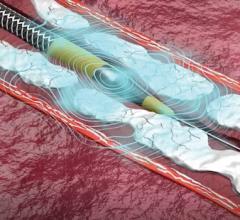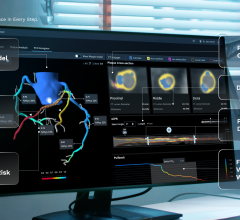
November 18, 2016 — Mitralign Inc. announced the successful compassionate use treatment of a patient suffering from tricuspid regurgitation (TR) with their investigational Trialign System. The patient was suffering from TR due to a cardiac implantable electronic device lead.
“We are pleased to be the first center in the world to report treatment of a patient with mechanically induced TR due to their pacemaker lead,” commented Christopher Meduri, M.D., MPH, interventional cardiologist at Piedmont’s Marcus Heart Valve Center, Atlanta. “We continually receive referrals for patients looking for treatment of their tricuspid regurgitation, and a substantial proportion of these patients have leads. This large population of patients has a significant unmet need that could potentially be addressed with a less invasive intervention like this.”
The Trialign System is an investigational device and is limited by federal (or United States) law to investigational use only. It is not available for sale or commercial distribution. With the small footprint of the implant, the Trialign System is designed to offer versatility as a frontline solution to address patients with TR. The SCOUT I Early Feasibility Study utilizing the Trialign System is currently enrolling patients in the United States. This patient was treated under the U.S. Food and Drug Administration (FDA) Compassionate Use Exemption.
Tricuspid regurgitation occurs when the tricuspid valve fails to open and close properly, causing blood to flow backwards into the right atrium. If left untreated, TR can lead to heart enlargement and heart failure. In the United States and Europe alone, there are an estimated 7.2 million patients suffering from TR1.
It is estimated that 50 percent of patients with mitral regurgitation have moderate to severe tricuspid regurgitation2. The annual incidence of patients with TR is increasing with an estimated 220,000 patients in the U.S., and 330,000 patients in the EU developing moderate-severe TR each year1. Despite the large prevalence of patients, TR is generally untreated by surgery, with approximately 10,000 tricuspid valve surgeries performed annually in the U.S.3 Annuloplasty repair is the most used technique for tricuspid valve surgery and represents 90 percent of the current volume. Isolated tricuspid valve surgery is particularly rare, representing only 10 percent of current procedures, while the remaining 90 percent are performed in conjunction with other left-heart surgeries3, 4. Permanent pacemaker (PPM) or implantable cardioverter defibrillator (ICD) lead placement has been shown to increase the frequency and/or severity of TR in multiple reports5-11.
For more information: www.mitralign.com
References:
1. Tricuspid Regurgitation Global Strategic Market Assessment. Dymedex Consulting. 2016
2. Argarwal, S, et al. Interventional Cardiology Perspective of Functional Tricuspid Regurgitation. Circ Cardiovasc Interv 2009;2:565-573
3. STS Adult Cardiac Surgery Database Executive Summary. 2014
4. Armen K. et al. Ann Thorac Surg. 2013;96:1546–52
5. Fanari Z. et al. The effects of right ventricular apical pacing with transvenous pacemaker and implantable cardioverter defibrillator on mitral and tricuspid regurgitation. J Electrocardiol 2015; 48: 791-797.
6. Sadreddini M, et al. Tricuspid valve regurgitation following temporary or permanent endocardial lead insertion, and the impact of cardiac resynchronization therapy. Open Cardiovasc Med J 2014; 8: 113-120.
7. Paniagua D. et al. Increased prevalence of significant tricuspid regurgitation in patients with transvenous pacemaker leads. Am J Cardiol 1998; 82: 1130-2.
8. Klutstein M, et al. Tricuspid incompetence following permanent pacemaker implantation. Pacing Clin Electrophysiol 2009: 32(Suppl 1): S135-7.
9. Kim JB, Spevack DM, Tunick PA, et al. The effect of transvenous pacemaker and implantable cardioverter defibrillator lead placement on tricuspid valve function: an observational study. J Am Soc Echo cardiogr 2008; 21: 284-7.
10. Mazine A, et al. Transvalvularpacemaker leads increase the recurrence of regurgitation after tricuspidvalve repair. Ann Thorac Surg 2013; 96: 816-22.
11. Alizadeh A, et al. Induction and aggravation of atrioventricular valve regurgitation in the course of chronic right ventricular apical pacing. Europace 2011; 13: 1587-90.


 November 14, 2025
November 14, 2025 









